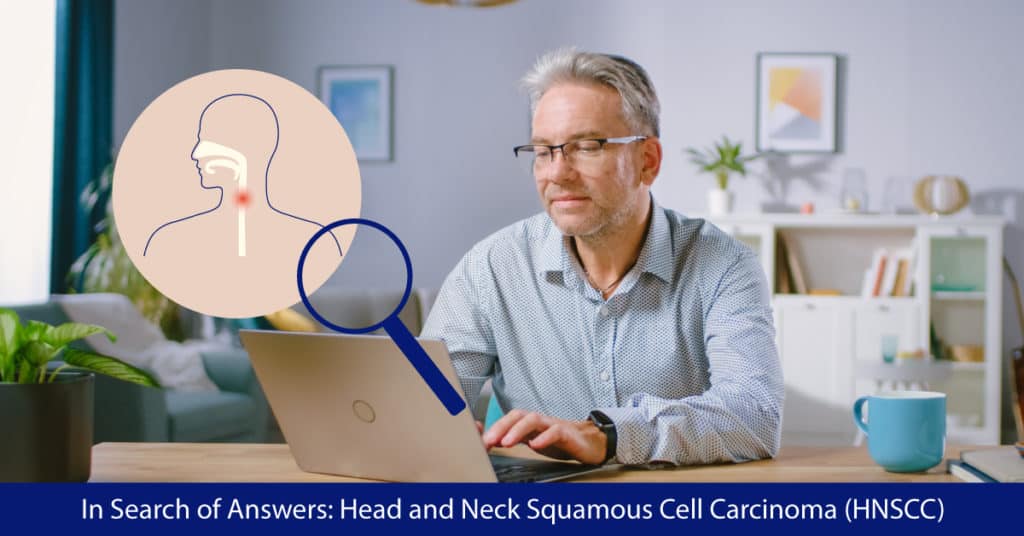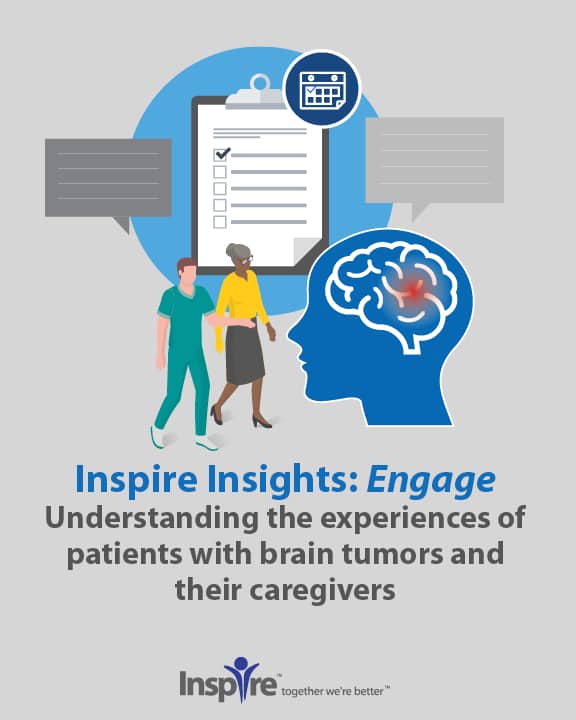In Search of Answers: Head and Neck Squamous Cell Carcinoma (HNSCC)

By Kathleen Hoffman, PhD, MSPH
The basic dry facts about Head and Neck Squamous Cell Cancer (HNSCC) are that it is a cancer of the mucosal lining of the oral cavity and larynx; typical treatments include surgical intervention, chemotherapy, radiation, and, more recently, immunotherapy, followed by various kinds of rehabilitation and reconstruction. However, let’s make it real. A member of Inspire’s Head and Neck Cancer Alliance community describing their Survivor Story said:
I am [an] oral cancer (Tongue cancer) survivor (my age is ___ years). In [date] diagnosed with tongue cancer followed by Chemo and rediation. I had 32 rediation with high intensity. I complete[d] my treatment in [date]. Result are encouraging and my Scan came clear. Now doing Theraphy of tongue to get back to eat[ing] solid food.
There are two typical pathways to HNSCC, one associated with alcohol and tobacco use, and the other through sexual transmission of HPV, the human papilloma virus. Patients seek help when they are having difficulty eating, pain in swallowing, or when their voice becomes hoarse. Unfortunately, by the time of diagnosis, the majority of patients already have advanced-stage HNSCC. 1
In the US, HNSCCs are rare. 2While at least 75% of head and neck cancers are caused by tobacco and alcohol use, in the US, the ratio is changing as more people are diagnosed with HPV-related HNSCC.3 . More soberingly, the incidence of HNSCC is anticipated to increase by 30% (that is, 1.08 million new cases annually) by 2030.3
At age 67, I was diagnosed with HPV oropharyngeal cancer early [date] after noticing a swollen lymph node on the right side of my neck. This was caused by a SCC tumor in the tonsil. In [date], I had surgery to remove the tonsil tumor and 44 lymph nodes on my right side. Only one lymph node was diseased. I started radiation treatments to both sides of the neck in [date]. I have completed 11 of 33 treatments and started feeling loss of saliva in the second week, soreness in the throat at start of week three.
In April, Terry A. Day, MD, the chairman of the Head and Neck Cancer Alliance (Inspire’s community partner), was a featured speaker at a CancerCare Connect Education Workshop called “Treatment Update on Oral Head and Neck Cancer.” His “take home point” was about making decisions in treatment. He said “…multidisciplinary input is crucial,” adding that “a surgeon, a radiation oncologist, a medical oncologist, a dentist, a dietician and a speech pathologist all have to be part of every treatment regimen.”4
Over the past three decades, HNSCC survival rates have increased modestly, due in part to improved survival rates in HPV-positive HNSCC. Another panel member, Krzystof Misiukiewicz, MD, MSCR, Associate Professor of Medicine at Mt. Sinai Hospital, strongly encouraged participating in clinical trials, and cited a patient of his who survived metastatic cancer after taking part in a trial of an experimental drug as an example. “We are not going to be able to make any progress without your participation.” He is also enthusiastic about immunotherapy for HNSCC, noting that two drugs have recently been FDA approved for that indication.4
An Inspire member wrote about their experience with one of the new immunotherapies:
I had metastatic head and neck cancer and went through all the “horrific” treatments. Then as a last resort I got [nivolumab] which is extremely similar to [pembrolizumab], and after about 4 months the tumors shrank and then disappeared. I am now cancer free.
Over 24,000 Inspire members are patients with HNSCC and their caregivers. On Inspire, over 48,500 posts share patient and caregiver life experiences with this group of diseases along with these cancer patients’ and their caregivers’ strong desire to be part of research.
Effective treatment for recurrent disease is desperately needed. That and the psychological distress from physical challenges and compromised quality of life among survivors of this cancer leads to an increased rate of suicide (63.4 cases per 100,000 individuals) compared with survivors of other cancers (23.6 cases per 100,000 individuals).1
Inspire members do all they can to provide support to each other. As one Inspire member said,
Like I said everyone is different but what you are going through is very doable. Take one day at a time, lean on your support team and doctors. Before long this bump in the road will seem like just a bad dream. Good luck.
Inspire offers a trusted community to patients and caregivers. Our goal with this blog, this website and our content is to provide the life science industry access to the true, authentic patient voice. In so doing, we support faithful operationalization of patient-centricity. Take a look at our case studies, eBooks and news outlet coverage.
References:
1 https://www.nature.com/articles/s41572-020-00224-3
2Fakhry C, Krapcho M, Eisele DW, D’Souza G. Head and neck squamous cell cancers in the United States are rare and the risk now is higher among white individuals compared with black individuals. Cancer. 2018 May 15;124(10):2125-2133. doi: 10.1002/cncr.31322. Epub 2018 Mar 13. PMID: 29533459; PMCID: PMC5953421.
3https://www.cancer.gov/types/head-and-neck/head-neck-fact-sheet
4https://edge.media-server.com/mmc/p/x398jmf7






